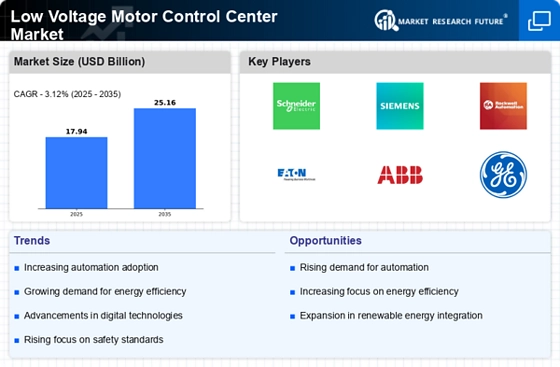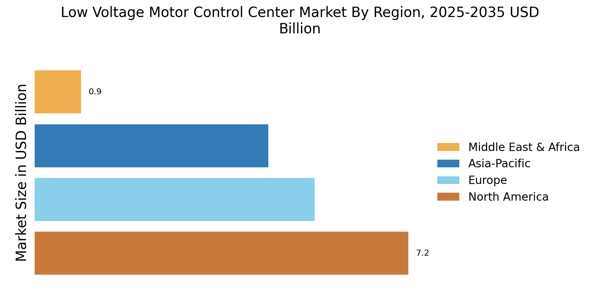Integration of IoT Solutions
The integration of Internet of Things (IoT) solutions into the Low Voltage Motor Control Center Market is transforming operational efficiencies. IoT-enabled motor control centers facilitate real-time monitoring and predictive maintenance, which can lead to reduced downtime and enhanced productivity. As industries increasingly adopt smart technologies, the demand for IoT-compatible motor control centers is likely to rise. This trend is supported by the growing need for data-driven decision-making in manufacturing and energy sectors. The market for IoT in motor control is projected to expand significantly, with estimates suggesting a compound annual growth rate of over 20% in the coming years. This integration not only optimizes performance but also aligns with sustainability goals, making it a pivotal driver in the Low Voltage Motor Control Center Market.
Emphasis on Energy Efficiency
Energy efficiency remains a critical focus within the Low Voltage Motor Control Center Market. As energy costs continue to rise, industries are increasingly seeking solutions that minimize energy consumption while maximizing output. Low voltage motor control centers equipped with advanced energy management systems can significantly reduce energy waste. Reports indicate that energy-efficient motor control solutions can lead to savings of up to 30% in energy costs. Furthermore, regulatory frameworks are becoming more stringent, pushing companies to adopt energy-efficient technologies. This regulatory pressure, combined with the financial incentives associated with energy savings, is likely to drive the adoption of energy-efficient motor control centers, thereby propelling growth in the Low Voltage Motor Control Center Market.
Rise of Automation in Industries
The rise of automation across various industries is significantly influencing the Low Voltage Motor Control Center Market. As manufacturers and service providers seek to enhance productivity and reduce labor costs, the implementation of automated systems is becoming more prevalent. Low voltage motor control centers are integral to these automated systems, providing precise control over motor operations. The market for industrial automation is expected to grow at a robust pace, with estimates suggesting a compound annual growth rate of around 10% over the next several years. This trend indicates a strong demand for advanced motor control solutions that can seamlessly integrate with automated processes, thereby driving growth in the Low Voltage Motor Control Center Market.
Growth in Renewable Energy Sector
The expansion of the renewable energy sector is a notable driver for the Low Voltage Motor Control Center Market. As countries strive to meet renewable energy targets, the demand for efficient motor control solutions in wind, solar, and hydroelectric power generation is increasing. Low voltage motor control centers play a crucial role in managing the operation of renewable energy systems, ensuring optimal performance and reliability. The International Energy Agency has projected that renewable energy sources will account for a significant portion of the global energy mix by 2030. This shift towards renewables necessitates the integration of advanced motor control technologies, thereby creating opportunities for growth within the Low Voltage Motor Control Center Market.
Increasing Demand for Compact Solutions
The increasing demand for compact and modular solutions is shaping the Low Voltage Motor Control Center Market. As industries strive for space optimization and flexibility in their operations, the need for smaller, more efficient motor control centers is becoming apparent. Compact motor control centers not only save space but also offer enhanced performance and easier installation. The trend towards miniaturization is particularly evident in sectors such as manufacturing and commercial buildings, where space constraints are common. Market analysis suggests that the demand for compact motor control solutions is likely to grow, driven by the need for efficient use of space and resources. This shift towards compact solutions is expected to be a key driver in the Low Voltage Motor Control Center Market.


















Leave a Comment